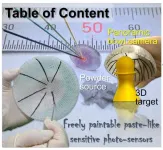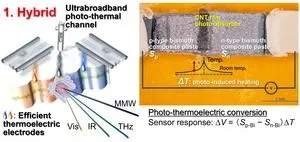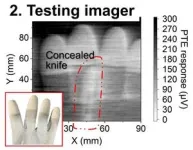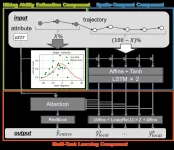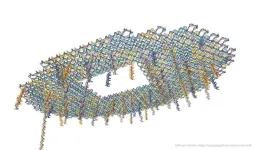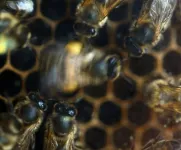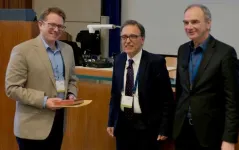(Press-News.org)
While photo-thermoelectric (PTE) sensors are potentially suitable for testing applications, such as non-destructive material-identification in ultrabroad millimeter-wave (MMW)–infrared (IR) bands, their device designs have primarily employed a single material as the channel. In general, PTE sensors combine photo-induced heating with associated thermoelectric (TE) conversion, and the employment of a single material channel regulates the utilization of devices by missing the opportunity for fully utilizing their fundamental parameters. Here, long-standing technical difficulties in the PTE sensor design field induce such crucial situations, where typical constituent materials exhibit trade-off trends between photo-absorptance values (for heating) and the Seebeck coefficients (for TE conversion).
To this end, this manuscript made the following significant contributions.
Developing the PTE sensor structure in an effective hybrid combination between bismuth composite (Bicom) TE electrodes (Seebeck coefficient > 100 µV/K) and highly efficient carbon nanotube (CNT) film photo-thermal absorber channels.
Performing photo-detection operations by the sensor with over ten-fold response intensities than those of single-material PTE detectors (typically: pn-junction CNT films) as making the most of the above advantageous hybrid strategy, satisfying the readable signal range criteria (> several millivolts) for the device coupling with portable circuit modules.
Designing the hybrid PTE sensor into all-solution-processable fabrication configurations by effectively arranging Bicom powders with conductive solvents and surfactants as paste-like stable TE converting electrodes, along the inherently ink-formed CNT film absorber.
Achieving ultrabroad MMW–IR operations with the hybrid paste PTE device over typical wideband detectors in comparable sensitivities (minimum noise equivalent power: 560 fWHz−1/2) to existing narrowband sensors, while simultaneously maintaining optical stabilities against severe environmental conditions (e.g., high-temperatures and cyclic deformations).
Demonstrating functional non-destructive imaging inspections at high-usability with the hybrid PTE sensor based on the advantages above optical features and paste-unique freely paintable device setups, such as omni-directional observations of a 3D target without blin-spot by fabricating an easy-to-handle panoramic bowl camera module.
The paper was published online in the international scientific journal, Small Science (February 20, 2025).
*****************************************
<Researcher>
Kou Li: Assistant Professor, Department of Electrical, Electronic, and Communication Engineering, Faculty of Science and Engineering, Chuo University
Yuto Matsuzaki: Master course student, Department of Electrical, Electronic, and Communication Engineering, Graduate School of Science and Engineering, Chuo University
Yukio Kawano: Department of Electrical, Professor, Electronic, and Communication Engineering, Faculty of Science and Engineering, Chuo University
Reiji Tadenuma: Bachelor student (at the time of research), Department of Electrical, Electronic, and Communication Engineering, Faculty of Science and Engineering, Chuo University
Yuto Aoshima: Bachelor student (at the time of research), Department of Electrical, Electronic, and Communication Engineering, Faculty of Science and Engineering, Chuo University
<Author>
Yuto Matsuzaki†,1, Reiji Tadenuma†,1, Yuto Aoshima†,1, Minami Yamamoto1, Leo Takai1, Yukito Kon1, Daiki Sakai1, Norika Takahashi1, Ryo Koshimizu1, Qi Zhang1, Naoko Hagiwara1, Meiling Sun2,3, Daiki Shikichi1, Raito Ota1, Sayaka Hirokawa1, Yukio Kawano*1,4,5, and Kou Li*,1
†Co-first author
*Corresponding author
K.L., Y.M., and Y.Ka. conceptualized this work and coordinated the experiments. Y.M. and K.L. wrote the manuscript. Y.M., R.T., Y.A., M.Y., L.T., Y.Ko., D.Sa., N.T., R.K., Q.Z., N.H., M.S., D.Sh., R.O., S.H., and K.L. performed the experiments.
<Affiliation>
1Department of Electrical, Electronic, and Communication Engineering, Faculty of Science and Engineering, Chuo University
2Laboratory for Future Interdisciplinary Research of Science and Technology, Tokyo Institute of Technology
3Department of Electrical and Electronic Engineering, School of Engineering, Tokyo Institute of Technology
4National Institute of Informatics
5Kanagawa Industrial Institute of Science and Technology
END
Psychological factors have a greater impact on the severity of symptoms in esophageal diseases than objective evaluations, such as acid reflux and esophageal motility function. Although there are questionnaires that assess general psychological states in Japan, there were none that were specific to esophageal symptoms. In the United States, meanwhile, the Esophageal Hypervigilance and Anxiety Scale (EHAS) questionnaire that evaluates symptom-specific hypervigilance and anxiety for esophageal symptoms was developed in 2018.
In an effort to expand the use of EHAS, Dr. Akinari Sawada’s research group at Osaka Metropolitan ...
At the University of Electro-Communications, a research team led by Mizuho Asako, Yasuyuki Tahara, Akihiko Ohsuga, and Yuichi Sei has developed a new deep learning model called "HikingTTE" that significantly improves hiking travel time estimation. Hiking is popular worldwide, but accidents still occur when hikers underestimate the time needed to reach their destination.
This model could help reduce mountain accidents and improve hiker safety by providing more accurate travel time predictions. Previous hiking travel time estimation methods often use the relationship between slope (uphill or downhill) and walking speed. However, these ...
Birds worldwide make strategic decisions about how they live based on their environmental conditions. Some live fast, die young, and leave as many chicks as possible. Others live long and prosper by not breeding.
A new study of non-migratory birds provides clues about how climate change may affect the long-standing evolutionary strategies of feathered friends. The work is reported in this week’s Ecology Letters and was led by Michigan State University postdoctoral fellows of the MSU Institute for Biodiversity, Ecology, Evolution, and Macrosystems (IBEEM).
The ...
Highlight box
Key findings
• This study investigated the U-shaped nonlinear relationship between admission oxygen saturation (SpO2) and all-cause hospital mortality in patients with acute exacerbation of chronic obstructive pulmonary disease (AECOPD). The results showed that the lowest all-cause hospital mortality was observed at an SpO2 of 89.5%. Additionally, SpO2 was identified as an independent risk factor for predicting all-cause hospital mortality in AECOPD patients, providing valuable guidance for optimizing oxygen therapy in this population.
What is known and what is new?
• Most studies indicate that maintaining SpO2 levels between 88–92% provides ...
A largescale study has found huge variation between GP practices on whether they are likely to pick up prostate cancer using a blood test.
The University of Exeter led a study which aimed to investigate the proportion of patients whose prostate cancer was identified by using a prostate-specific antigen (PSA) test when patients had no symptoms.
The research published in the British Journal of General Practice and funded by Cancer Research UK, and, has found that one in five patients with prostate cancer in England are diagnosed after PSA testing when they had no symptoms – fewer than previously thought. The PSA test ...
New research suggests that antidepressants can accelerate cognitive decline in people with dementia. At the same time, some drugs appear to be less harmful than others, which can help doctors make better treatment decisions, according to the study published in BMC Medicine.
Antidepressants are often used to relieve symptoms such as anxiety, depression, aggressiveness, and sleep disturbances in dementia sufferers.
However, a new observational study based on data from the Swedish Dementia Registry (SveDem) shows that patients with dementia who are treated with antidepressants experience an increased cognitive decline compared to patients who do not ...
Using an approach called DNA origami, scientists at Caltech have developed a technique that could lead to cheaper, reusable biomarker sensors for quickly detecting proteins in bodily fluids, eliminating the need to send samples out to lab centers for testing.
"Our work provides a proof-of-concept showing a path to a single-step method that could be used to identify and measure nucleic acids and proteins," says Paul Rothemund (BS '94), a visiting associate at Caltech in computing and mathematical sciences, and computation and neural systems.
A paper describing the work recently appeared in the journal Proceedings of the National Academy of Sciences. The lead authors of ...
As far as animals go, honeybees are world-class dancers.
While not as deep and complex as a Super Bowl half-time show, the bees' moves, known as the “waggle" dance, convey very specific food foraging instructions to their nestmates. The direction the dancer moves explains to other bees which way to go, and the duration of the waggle dance, or the “run,” shows how far to go. Once other bees have been convinced to follow the directions, they are “recruited.” After receiving the instructions, these ...
A UC Riverside computer science team has developed a sensor-based technology that could revolutionize commercial beekeeping by reducing colony losses and lowering labor costs.
Called the Electronic Bee-Veterinarian, or EBV, the technology uses low-cost heat sensors and forecasting models to predict when hive temperatures may reach dangerous levels. The system provides remote beekeepers with early warnings, allowing them to take preventive action before their colonies collapse during extreme hot or cold weather or when the bees cannot regulate their hive temperature because of disease, pesticide exposure, food shortages, or other stressors. ...
University of Texas at Arlington physicist Ben Jones has received an international honor for his contributions to developing advanced instruments used in particle physics research.
Dr. Jones, an associate professor of physics, was awarded the 2025 International Committee for Future Accelerators (ICFA) Early Career Researcher Instrumentation Award. Presented by the ICFA Instrumentation Innovation and Development Panel, the award recognizes significant advancements in the innovation and development of new instrumentation for future accelerator experiments.
He accepted the award last week at the 2025 Vienna ...
